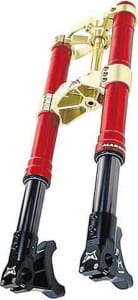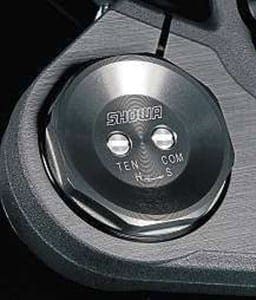A well set-up front end will give you more control, feel and confidence in your bike. We explain the tech behind forks…
How do forks work?
Cartridge forks have all of their valving inside a metal cylinder, or cartridge. This is bolted to the bottom of the fork so it moves up and down (compresses and rebounds) as the bike’s suspension hits bumps in the road.
There are two pistons in the cartridge – the rebound, which is fixed to the end of the damper rod, and the compression, which is fixed to the cartridge bottom, which remain stationary as the suspension compresses/rebounds.
The oil within the cartridge must be metered during both the compression and the rebound stroke to achieve damping control. The pistons have two different sizes of hole in them. The bigger ones, while offering no restriction, do have a one-way valve so their flow only works in one direction. In the other direction, the flap in the valve shuts off and the smaller holes start working – creating the piston’s damping. As the pistons face in opposite directions, they divide the damping equally without disturbing one another.
So when the fork compresses, More of the damper rod pushes into the cartridge, which forces oil through the smaller holes in the compression piston. As the forks extend, the two pistons effectively change jobs, with the rebound piston then providing its damping.
What are shims?
To refine damping control further, shims (flexible metal washers) are used. The oil flowing through the piston holes also has to get through a shim stack. Shims are generally arranged in a pyramid shape with the biggest ones closest to the piston. When the oil flows through the piston it forces the shims to deflect, or bend, away from the piston face. Depending on wheel speed movement (velocity), the shims will bend quickly or slowly, and either a little or a lot. This shim movement is what we call feel. This feel (stiffer, harder, plusher, softer) can be altered via different shim diameters, thicknesses and quantities, depending on rider requirements and style of riding (see ‘what does re-valving do?’).
Smaller shims affect the higher end of the speed range while bigger shims affect the lower end. Most damping systems are velocity dependent.
 What do adjusters do?
What do adjusters do?
Compression and rebound valves each have a small secondary passage, which are controlled by external adjusters, or cone shaped needles. They work by raising and lowering themselves through the passage. The further the needle is wound in, the more it plugs the hole, restricting the oil flow. The more it is turned out, the more of the hole is open, allowing the oil to flow more freely. More clicks ‘out’ will give a softer ride, more clicks ‘in’ will stiffen things up.
What does re-valving do?
With standard forks, the only thing that can be improved is the internals. By re-valving you are increasing/decreasing the damping forces at different velocities. A commonproblem is fork dive. To slow the dive rate down, damping can be increased to provide a stiffer feel. This is commonly done via the shim stacks. A lot depends on the original piston size. The bigger the piston, the bigger the shims that can be used. The bigger the shim diameter, the more shim ‘bend’ you can get. Generally, if you wantastiffer set-up, changing the shims closest to the piston face will help.
Re-valving starts with changing the shim stacks. Sometimes new pistons will be needed to fine-tune the feel still further. Also, trying a different viscosity/quantity of oil canhelp as the amount of fluid inside the damper also affects damping forces. The less fluid there is the hotter forks will run, leading to fork fade. Theremust alsobe enough oil present to lubricate the mechanism properly, including seals. Changing the spring rate by using springs suitable for your weight can also help.
Why do damping curves matter?
Adamping curve is the measured force of the shims opening. It’s all about at what speed the shims start to open at. Most riders prefer a set-up that is firm, plush, with resistance to bottoming. For example, if you want good lowspeed feel, mid-turn stability yet still soak bumps up, a digressive damping curve that climbs sharply to start off with, followed by a more gradual rise, should do the job. How top suspension tuners determine what shim/piston/spring/oil combinations will mirror any particular curve is why they get paid a lot of money.
What are closed cartridges?
A completely closed cartridge system means having the lubricatingoil for the inner and outer tube totally segregated from the damping cartridge itself. The benefits are no oil contamination (no brake dust, particles breaking off from inside surfaces etc), so the whole system will last longer and operate more consistently and therefore efficiently. Cavitation is also greatly reduced (where oil and air mix and ‘foam’, resulting in loss of damping).
What about fork diameter?
The number quoted on forks, be it 41, 43 or 50mm, refers to the lower slider (or inner tube) diameter. The reason diameters vary is that the bigger the tube, the more rigidity there is, which can give more front-end feel. However, larger tubes can be too stiff for some riders, as it affects howmuch they flex from side to side – some flex is still needed.
With racing forks, the inner tube’s diameter canhave the biggest effect on air pressure, or spring. If you compare a 41mm diameter fork to a 48mm one, assuming the oil level is the same, say, 150mm), when the fork compresses, you get what’s known as an exponential curve of air pressure. With the smaller fork diameter, the curve will rise very quickly, and with the larger diameter the curve will be much more gradual. How this translates to feel is with the 41mm forks, the air pressure will build up quickly, so in a brake-hard, turn-quickly situation, the front end could be lost. Bigger diameter forks’ air pressure doesn’t build up so quickly, which results in a plusher, more stable feel.
A fork diameter of between 43mm and 45mm should be adequate for most fast road riders.
 What exactly are BPFs?
What exactly are BPFs?
Developed by Showa, Big Piston Forks (BPFs) effectively convert the whole fork leg into the cartridge, allowing the use of a much bigger main piston that incorporates both rebound and compression damping within it. This allows much more oil to flow through at lower pressures (greater volume means lower pressure, meaning that the oil travels at lower speeds). This improves low-speed damping control, such as when the forks start to compress under braking, reducing fork dive. It should also reduce oil cavitation, which causes irregular damping problems.
By getting rid of some of the parts needed in a conventional cartridge fork (internal cylinder, compression piston), this reduces unsprung weight. Also, as the spring preload is now at the bottom of the fork (compression/ rebound adjusters are top-mounted), this eliminates the need for a sleeve running up to the top fork cap.
Improving the damping control in this way should provide greater feel, less high-speed vibration, reduced dive, better connection to the road through the tyres, increased front-end confidence and less chance of hydraulic lock (where the level of fluid inside the unit affects the compression ratio – if the level’s too high, then the pressure may get so high as to cause lock, preventing further suspension travel).
Many sportsbikes now run BPF, such as the latest Kawasaki and Suzukis (the recently launched GSX-R600 K11 has them – see page 8 for the first ride report).
OE road versus Superbike forks
Standard forks are designed to work in a wide variety of road conditions, having to deal with potholes, bumps and uneven surfaces. Although these are pretty good, they will have a tendency to dive too quickly if you use them on a track as the internal damping isn’t controlled enough. Most springs are also harder than needed for track use, to compensate for lack of correct damping.
Superbike forks are slightly heavier than OE ones as more rigidity is needed. The materials used are of a much higher quality, with aircraft standard metal put in certain areas such as the fork bottom and axle clamp, to provide the right amount of strength where needed. The upper tubes have a bigger sliding action as this reduces excess flex, which can induce drag on the bushes. Lower fork tubes can have a DLC (diamond-like carbon) coating that offers excellent low-friction and abrasion resistant properties. They are tapermachined inside like a cone, as this process provides more rigidity.
Tolerances are also much closer, for example the running clearance between the bush and the fork tube. Low friction PFTE coated or special oil seals are often used to also reduce drag. Fork surface finishes such as titanium nitride are used to reduce friction and eliminate potential binding.
 Suspension specialists
Suspension specialists
Maxton Suspension 01928 740531 or www.maxtonsuspension.co.uk
K-Tech 01530 810625 or www.k-tech.uk.com
Reactive Suspension 01347 811529 or www.reactivesuspension.com
Road and Race Suspension 01635 299288 or www.roadandracesuspension.co.uk
MH Racing 01249 721001 or www.mhracing.com
KP Racing Services 0845 4595409 or www.kprservices.co.uk
MCT Suspension 01449 777161 or www.mctsuspension.com
Harris Performance 01992 532501 or www.harrisperformance.co.uk
Full Travel Suspension 01284 752102 or www.wpsuspension.co.uk
Solent (UK) Ltd 02392 505322 or www.marzocchi.co.uk
Pitted Forks 01582 571234 or www.pittedforks.co.uk



